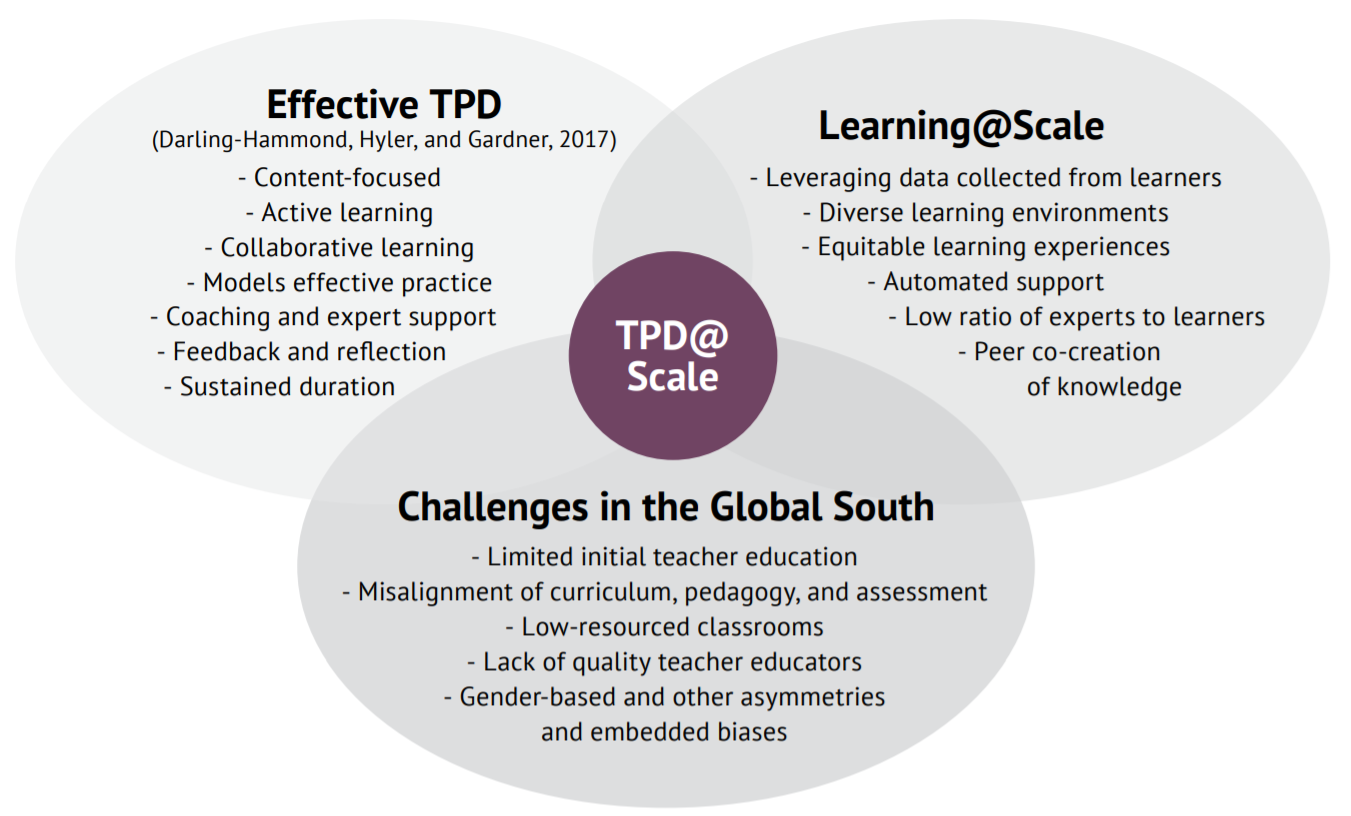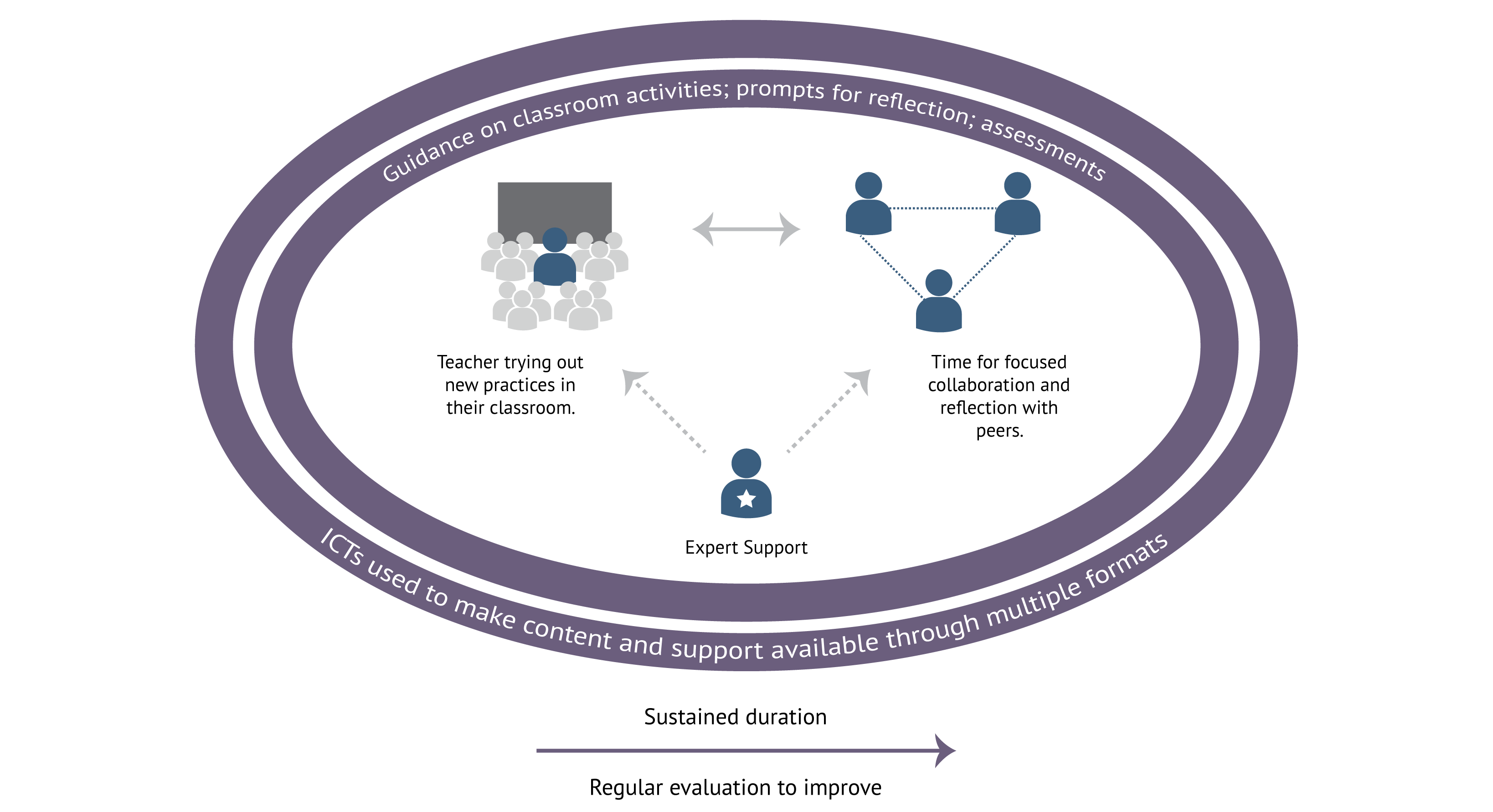Global challenges and TPD@Scale
| Site: | OpenLearn Create |
| Course: | TPD@Scale: Introduction and key principles |
| Book: | Global challenges and TPD@Scale |
| Printed by: | Guest user |
| Date: | Sunday, 23 November 2025, 7:11 AM |
1.8 Global challenges and evidence of what works
Across the globe, there is an urgent need to improve inclusion in education and improve learning outcomes. An estimated 258 million children, adolescents, and youth are not in school, and a majority of school-age children in low- and middle-income countries are not achieving minimum proficiency in basic skills.
Empowered, motivated, and capable teachers are central to changing this situation. The connection between quality teaching and learning outcomes is well-documented. This demands high-quality, equity-focused TPD for all teachers.
School- and classroom-based learning can make a powerful impact on teachers’ ways of observing, thinking and acting. For teachers, learning through practice is equitable, because all teachers can access it. Learning through practice is also efficient, in terms of time and resourcing. The classroom and the school can be important locations for teacher development, where teachers can try out new ideas and methods, and see the impact on students.
There is not enough time, or resource, to take all teachers out of schools and into training institutions for periods of high quality TPD that is disconnected from their classroom realities. Professional learning and change must take place ‘on the job’, in schools and workplaces. It is the only way that scalable, sustainable teacher development that benefits children’s learning will happen.
TPD@Scale is based on two bodies of evidence:
- Effective TPD
- Effective learning at scale: learning environments where information and communication technologies (ICTs) help large numbers of learners to participate without having to be physically present in the same space
What do we know about effective TPD?
- It recognises teachers as professionals
- It is situated, authentic and practice based
- It is content-focused
- It involves active learning
- It promotes peer learning and collaboration in communities of teachers
- It models effective practice
- It helps teachers to focus on the learning needs of all their students
- It provides space for feedback and reflection
- It is for a sustained duration
- It offers coaching and expert support
What do we know about effective learning at scale, for example, in a Massive Open Online Course for thousands of teachers?
- There is a low ratio of experts to learners
- It can be applied in diverse learning environments
- It provides equitable learning experiences
- It provides automated content and support
- There is flexible access for learners
- It collects and analyses data from learners in order to improve the learning experience
- It support peer co-creation of knowledge
What are the challenges to high-quality, equitable TPD in the Global South?
- There is limited initial teacher education
- There is mis-alignment of curriculum, pedagogy and assessment
- There are low-resource classrooms
- There is a lack of quality teacher educators
- There are gender-based biases and other biases

1.9 TPD@Scale Framework
TPD@Scale programmes use knowledge of effective TPD and knowledge of effective learning at scale to create a set of core components for teacher development in diverse digital learning environments.
Watch this video about the six components of the TPD@Scale Framework:
In the Resources section, you will find the TPD@Scale Working Paper, which gives more detail and information about the Framework and how it can be operationalized at scale.
1.10 TPD@Scale core components
Look at this diagram of the core components of the TPD@Scale Framework.

If you are studying with others, sit with a partner and describe this diagram to each other.
What do you see in the diagram? How do the different components seem to be working?
Click to compare your ideas with some of our ideas. Then continue the activity.
To complete this course, answer these questions. You can choose to write in your Personal Blog.
If you are studying in a group, discuss the questions together.
In your TPD context, are any of these components currently applied? Explain what these are.
Are there other components in the model that are not applied in your context, but could be applied? Explain what these components could be, and what would need to happen in order to implement these.
What digital technologies for TPD work best in your region, in terms of teacher access and connectivity? If you are not sure, how might you find out?
Congratulations! You have completed Course 1.
You have explored TPD@Scale principles and core components, and you have considered how TPD@Scale responds to global challenges in teacher development. You have also started to look at elements of TPD@Scale in practice.
In Course 2, you will examine TPD@Scale case studies in depth.
You can review any sections of Course 1. Then evaluate your learning by taking the quiz. When you pass the quiz, you achieve a certificate of completion and a digital badge. The pass rate for the quiz is 70%, and you have three attempts to pass it. Good luck!
The digital badge is not a formal qualification, and it does not lead to certification. It is an acknowledgement of your completion of the course, your participation and achievement.